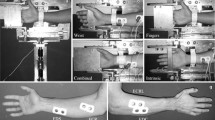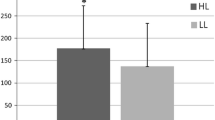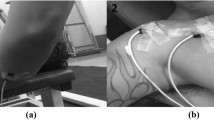Abstract
The differences between rock climbers and controls in finger flexor (FF) muscles’ motor control were determined in 11 climbers and 10 sedentary participants. Maximal voluntary contraction (MVC) was assessed and after 5 min of rest an isometric contraction at 80% MVC was performed until exhaustion. During contraction, the force signal was recorded, from which the variation coefficient (VC) was then calculated as an index of force control accuracy. Climbers showed significantly higher MVC (+46%, p<0.05) and MVC per unit of muscle-plus-bone area (MVC/MBA; +13%, p<0.05). Endurance time at 80% MVC was 43% longer in climbers than in controls (33±4 vs. 23±5 s, respectively; p<0.05). VC throughout the first 20 s of contraction was significantly lower in climbers than in controls (p<0.05). Maximum force results and force signal analysis during constant-load contraction at 80% MVC revealed significant differences in muscle characteristics and motor control between the two groups. In particular, climbers showed stronger and more efficient FF muscles, which were capable of sustaining the requested effort (80% MVC up to exhaustion) for a longer period of time and with a steadier force output. These results suggest a shift of climbers’ muscles toward faster and more resistant motor units due to years of high-intensity isometric contractions typical of this physical activity.
Similar content being viewed by others
References
Ferguson RA, Brown MD (1997) Arterial blood pressure and forearm vascular conductance responses to sustained and rhythmic isometric exercise and arterial occlusion in trained rock climbers and untrained sedentary subjects. Eur J Appl Physiol Occup Physiol 76:174–180
Watts PB, Daggett M, Gallagher P, Wilkins B (2000) Metabolic response during sport rock climbing and the effects of active versus passive recovery. Int J Sports Med 21:185–190
Quaine F, Vigouroux L (2004) Maximal resultant four fingertip force and fatigue of the extrinsic muscles of the hand in different sport climbing finger grips. Int J Sports Med 25:634–637
Hakkinen K, Kallinen M, Izquierdo M et al (1998) Changes in agonist-antagonist EMG, muscle CSA, and force during strength training in middle-aged and older people. J Appl Physiol 84:1341–1349
Garfinkel S, Cafarelli E (1992) Relative changes in maximal force, EMG, and muscle cross-sectional area after isometric training. Med Sci Sports Exerc 24:1220–1227
Semmler JG (2002) Motor unit synchronization and neuromuscular performance. Exerc Sport Sci Rev 30:8–14
Judge LW, Moreau C, Burke JR (2003) Neural adaptations with sport-specific resistance training in highly skilled athletes. J Sports Sci 21:419–427
Del Balso C, Cafarelli E (2007) Adaptations in the activation of human skeletal muscle induced by short-term isometric resistance training. J Appl Physiol 103:402–411
Grant S, Hynes V, Whittaker A, Aitchison T (1996) Anthropometric, strength, endurance and flexibility characteristics of elite and recreational climbers. J Sports Sci 14:301–309
Mermier CM, Janot JM, Parker DL, Swan JG (2000) Physiological and anthropometric determinants of sport climbing performance. Br J Sports Med 34:359–365; discussion 366
de Koning FL, Binkhorst RA, Kauer JM, Thijssen HO (1986) Accuracy of an anthropometric estimate of the muscle and bone area in a transversal cross-section of the arm. Int J Sports Med 7:246–249
Basmajian JV, De Luca CJ (1985) Muscles alive. Their functions revealed by electromyography. Williams and Wilkins Waverly Press, Baltimore
Davies J, Parker DF, Rutherford OM, Jones DA (1988) Changes in strength and cross sectional area of the elbow flexors as a result of isometric strength training. Eur J Appl Physiol Occup Physiol 57:667–670
Jones DA, Rutherford OM, Parker DF (1989) Physiological changes in skeletal muscle as a result of strength training. Q J Exp Physiol 74:233–256
McDonagh MJ, Davies CT (1984) Adaptive response of mammalian skeletal muscle to exercise with high loads. Eur J Appl Physiol Occup Physiol 52:139–155
Ebersole KT, O’Connor KM, Wier AP (2006) Mechanomyographic and electromyographic responses to repeated concentric muscle actions of the quadriceps femoris. J Electromyogr Kinesiol 16:149–157
Gondin J, Guette M, Ballay Y, Martin A (2005) Electromyostimulation training effects on neural drive and muscle architecture. Med Sci Sports Exerc 37:1291–1299
Rabita G, Perot C, Lensel-Corbeil G (2000) Differential effect of knee extension isometric training on the different muscles of the quadriceps femoris in humans. Eur J Appl Physiol 83:531–538
Moritani T, deVries HA (1980) Potential for gross muscle hypertrophy in older men. J Gerontol 35:672–682
Antonio J, Gonyea WJ (1993) Skeletal muscle fiber hyperplasia. Med Sci Sports Exerc 25:1333–1345
Gollnick PD, Timson BF, Moore RL, Riedy M (1981) Muscular enlargement and number of fibers in skeletal muscles of rats. J Appl Physiol 50:936–943
Kawakami Y, Nakazawa K, Fujimoto T et al (1994) Specific tension of elbow flexor and extensor muscles based on magnetic resonance imaging. Eur J Appl Physiol Occup Physiol 68:139–147
Bottinelli R, Pellegrino MA, Canepari M et al (1999) Specific contributions of various muscle fibre types to human muscle performance: an in vitro study. J Electromyogr Kinesiol 9:87–95
Watts PB, Joubert LM, Lish AK et al (2003) Anthropometry of young competitive sport rock climbers. Br J Sports Med 37:420–424
Folland JP, Williams AG (2007) The adaptations to strength training: morphological and neurological contributions to increased strength. Sports Med 37:145–168
Hunter SK, Enoka RM (2003) Changes in muscle activation can prolong the endurance time of a submaximal isometric contraction in humans. J Appl Physiol 94:108–118
Author information
Authors and Affiliations
Corresponding author
Rights and permissions
About this article
Cite this article
Limonta, E., Cè, E., Veicsteinas, A. et al. Force control during fatiguing contractions in elite rock climbers. Sport Sci Health 4, 37–42 (2008). https://doi.org/10.1007/s11332-008-0065-3
Received:
Accepted:
Published:
Issue Date:
DOI: https://doi.org/10.1007/s11332-008-0065-3




